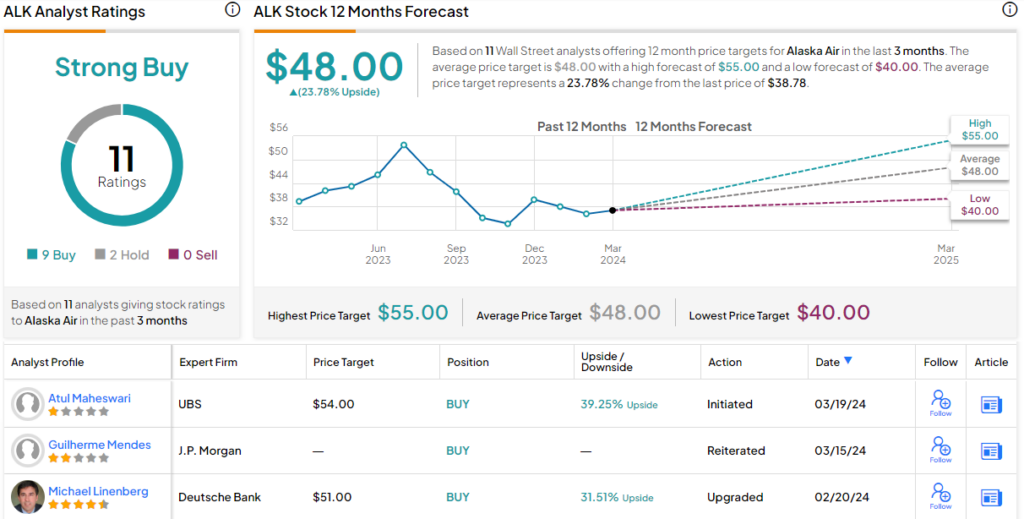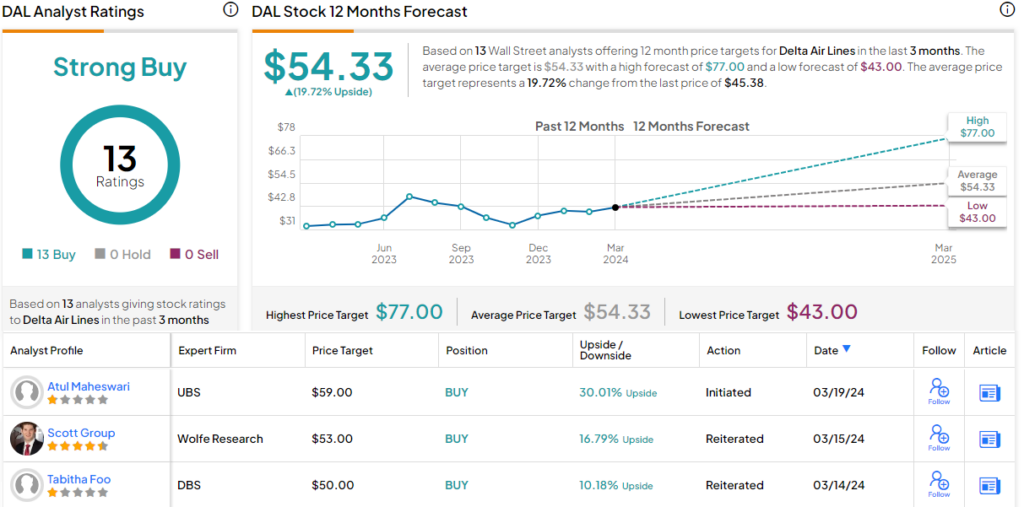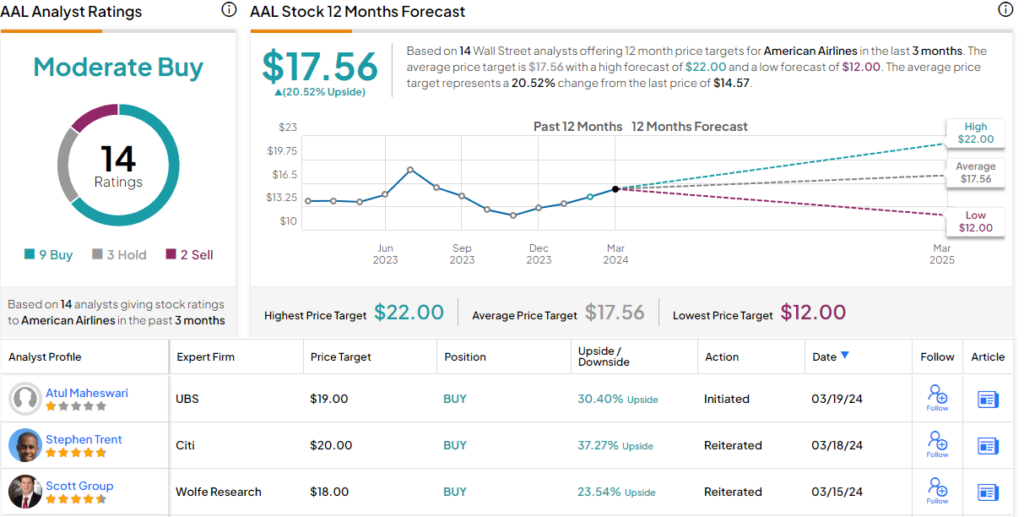A combination of receding headwinds and increased tailwinds is providing some extra lift to the airline industry. Passenger demand is steadily recovering post-COVID, in both the leisure and business segments, and the airlines overall are finding themselves able to meet the travel volumes. Reductions in general inflationary pressures, and the prospect of lower interest rates, are helping to offset likely permanent increases in labor and maintenance costs.
There are still idiosyncratic factors that the airlines have to deal with, in overall industry safety and reputation, but that’s likely to be counterbalanced by the increased presence of business travelers. Customer loyalty will also factor in as a supportive factor for some individual airline stocks.
UBS analyst Atul Maheswari has been looking into the details of the airline sector, as it continues to recover from the hit it took during the pandemic. He finds several reasons for optimism, and writes, in starting up his coverage of the US airline sector, “The key factor driving our positive bias is potential for cost pressures to moderate and margins to begin moving higher towards the end of 2024 and into 2025… We recommend buying select airline stocks in advance of this upcoming margin improvement later in 2024 and into 2025… We like airline stocks that have: 1) Strong FCF generation & solid or improving B/S, 2) Better near-term relative margin potential; 3) Exposure to business travel; 4) Strong customer loyalty & attractive loyalty program economics.”
Maheswari follows this up with several specific airline stock picks, choosing carriers that should see more gains going forward. According to the TipRanks database, these stocks have ‘Buy’ ratings and 20%-plus upside potential; here are the details.
Alaska Air Group (ALK)
First on our list is Alaska Air. This airline operates primarily on the West Coast of North America, and despite its name, the carrier is based in Seattle-Tacoma, in the State of Washington. While Alaska Air flies mainly along the West Coast, it does offer travel to destinations across the US, in much of Canada, and to Mexico, Central America, and the Caribbean. Alaska Air has a strong reputation for quality, but that took a hit recently when one of the airline’s Boeing 737 MAX 9 aircraft suffered a door blowout during flight.
The repercussions of that blowout are still rippling through the industry. Only minor injuries were reported in the accident, but investigations revealed that the aircraft in question had already been tagged for additional maintenance, and large-scale groundings of Boeing aircraft are still impacting the industry as a whole. The 737 is a widely popular passenger liner, and the MAX 9 is one of its most modern iterations – and makes up approximately 20% of Alaska’s fleet, 65 out of 314 total aircraft.
In another recent development, Alaska Air announced in December of last year that it had entered into a purchase agreement with Hawaiian Airlines. The deal will see Alaska buy Hawaiian for $1.9 billion, a sum that includes an $18 per share purchase price as well as Alaska’s assumption of $900 million in Hawaiian Air’s debt. The deal was approved by Hawaiian’s stockholders in February, but still requires regulatory approval before proceeding. The US Justice Department has requested additional information from the two airlines before rendering a decision. Pending approval, the airlines expect that the purchase transaction will be completed within 12 to 18 months of the original announcement date.
Turning to the financial side, we find that Alaska reported record-level revenues for the full-year 2023, of $10.4 billion at the top line. In the fourth quarter, revenue came to $2.55 billion, skimming above the forecast by $20 million and growing 3% year-over-year. The company’s quarterly bottom line, in non-GAAP measures, came to 30 cents per diluted share, based on net income of $38 million. The non-GAAP EPS was 12 cents per share better than had been expected. While the company burned cash in 4Q23, it saw a net positive operating cash flow for the full year of $1.1 billion.
Laying out the UBS view, analyst Maheswari notes that the stock stands to see benefits no matter how the Hawaiian Air deal shakes out, writing, “We believe ALK’s -15% underperformance vs the JETS ETF post HA deal announcement has created a compelling entry point. We think either one of the two outcomes (deal or no deal) will have positives for the stock. The merits of its standalone investment case are strong as our analysis shows the market is pricing in $1.57 bn in EBITDAR for ’25 vs. UBSe standalone ~$1.85 bn. Plus, we see optionality from higher synergies should the HA deal go through (UBSe proforma ’25 EBITDAR $2.35 bn).”
Summing up the situation, the analyst comes down with a bullish outlook: “Alaska is one of the best run US airlines with close to industry leading margins and a strong balance sheet. We see potential for ALK to benefit from several positive industry drivers over the next 12-18 months including improving revenue per available seat mile (RASM), moderation in cost pressures, and acceleration in biz travel. Plus, its West Coast exposure with hubs in SEA/ SFO/LAX makes it uniquely well placed to participate in an uptick in demand in that region. At these levels, we see a solid 3:1 upside/downside reward.”
Maheswari gives ALK shares a Buy rating along with a $54 price target that implies a one-year potential upside for the shares of 39%. (To watch Maheswari’s track record, click here)
Zooming out, the stock gets a Strong Buy rating from the Wall Street consensus, based on 11 reviews that include 9 Buys and 2 Holds. The shares are trading for $38.78 and their $48 average target price points toward a gain of ~24% in the next 12 months. (See ALK stock forecast)

Delta Airlines (DAL)
Next on our list, Delta Airlines, is one of the industry’s largest legacy carriers, as well as a component of the S&P 500 index. The airline keeps its headquarters, and its chief transport hub, in Atlanta, and maintains additional hubs across the US – in NYC, in Boston, in Detroit, in Seattle-Tacoma, and in Los Angeles, to name a few. Delta is consistently ranked among the top-five largest US airlines, whether counting by passengers carried, destinations served, daily flights, or fleet size. On the global scene, Delta flies to major destinations around the world. The company has international hubs in Amsterdam, London, and Paris, as well as Tokyo and Seoul.
Delta’s airliner fleet totals nearly 1,000 mainline planes, with a wide variety in types and models. The company operates both narrow- and wide-body aircraft, on both long- and short-range routes. Historically, the company has preferred to fly Boeing aircraft, but since 2008 has been adding significant numbers of Airbus planes to the fleet. For regional flights, the company operates a smaller fleet of jets from Bombardier or Embraer. The variety in the fleet composition poses challenges for maintenance and training, but helps to insulate the company from large-scale regulatory groundings. This is an important factor, as a variety of issues with Boeing, including regulatory matters and manufacturing delays, have caused Delta to delay delivery of ordered 737 MAX 10 aircraft – the most modern version of the 737 – until 2027.
The air industry’s rebound from the COVID shutdowns can be seen in the headline number from Delta’s 2023 financial results. The airline reported record full-year revenue of $58 billion, and 2023’s operating income of $5.5 billion was nearly double the 2022 figure.
For 4Q23, wrapping up the year, Delta reported $14.2 billion at the top line, up 5.8% y/y and beating the estimates by $420 million. The company saw quarterly earnings of $1.28 per share by non-GAAP measures, 12 cents better than had been anticipated pre-release. The company’s quarterly adj. operating income came to $1.3 billion, and had an operating margin of 9.7%.
The company’s anticipated margin profile caught the eye of UBS analyst Maheswari, who uses it as a starting point in his bullish update on the company, writing of Delta, “We are bullish on DAL as we see potential upside to FY’24E & FY’25E margins driven by an inflection in unit revenues and moderation in cost pressures beginning 2H’24. Our FY’24 pretax margin est is 9.9%, up ~30 bps YoY, vs cons of 9.5% while our FY’25 est is 10.9% vs. cons 10.6%. We believe DAL’s revenue per seat mile (RASM) growth will positively surprise the market in 2H’24E as domestic RASM moves higher & Atlantic RASMs remain steady with these tailwinds persisting into ’25 assuming continued supply discipline. This coupled with our expectations for a meaningful moderation in cost pressures in ’25 from better employee productivity, lower maintenance expenses, and slowing pilot wage increase to ~4% from ~7% in ’24 should lead to a more material acceleration in DAL’s margins in ’25E. We recommend buying the stock now in advance of this upcoming multi-quarter period of margin expansion beginning in 2H of this year.”
Maheswari puts his stance into perspective by giving DAL an initial rating of Buy, and complementing that with a $59 price target showing his confidence in a 30% upside on the one-year horizon.
DAL gets plenty of love from Wall Street, and the stock’s Strong Buy consensus rating is unanimous, based on 13 positive analyst reviews. The shares are trading for $45.38 and the $54.33 average price target points toward a 20% upside over the next year. (See DAL stock forecast)

American Airlines (AAL)
We’ll wrap up this list with American Airlines, another of the giant legacy carriers in the US air travel sector. American, like Delta, is a perennial contender for the top slots among the US airlines, by fleet size, annual revenue, and number of passengers carried. The company is the world’s largest operator of the Airbus A320 family of narrowbody jets, and also has a significant fleet of Boeing 737 models. The company’s widebody planes are all from Boeing, mainly of the 787 family. American Airlines saw its mainline fleet increase by more than 4% year-over-year in 2023, up to 965 aircraft. This is supplemented by 556 regional aircraft.
American Airlines, with its regional partner carriers, offers passengers nearly 6,700 daily flights, to some 350 destinations in over 50 countries around the world. The airline’s chief hub and headquarters are in Fort Worth, Texas, one of the nation’s major airports, serving Dallas as well, and the company has additional hubs in LA, Miami, New York, Chicago, Phoenix, and DC.
This airline maintains one of the youngest air fleets in the industry, and earlier this month announced a major purchase plan, totaling 260 new aircraft, primarily from Airbus and Embraer. The order includes 85 new A320neo models, and is planned to boost American’s premium seating capacity by up to 20% by 2026. The 90 Embraer E175 models included in the order will be operated by the company’s regional carriers.
American finished last year with $53 billion in annual revenue, a record for the company. Quarterly revenue in Q4 came to $13.06 billion, a figure that was down 1% from the prior-year period and was in-line with expectations. Fourth quarter earnings were 29 cents per share by non-GAAP measures, a full 21 cents per share better than the forecasts. The airline had a full-year operating cash flow of $3.8 billion, and recorded its highest full-year free cash flow, at $1.8 billion.
In his coverage of American, analyst Maheswari is impressed by the cash flow – and expects it to remain strong. He is bullish on this airline, saying of it, “We expect AAL should see both strong FCF generation and profit acceleration in the next 2-3 years, unlocking higher equity value as net debt moves lower and B/S is delevered. Importantly, we don’t think this is priced in as our analysis suggests the market is pricing in just ~$8 bn in EBITDAR for ’25 (vs. UBSe $8.7 bn) with cons. estimating only ~$3.1 bn in FCF for ’24 and ’25 combined vs. UBSe $4 bn. We see the potential for upwards earnings revision with our ’25 pretax margin est. at 5.9% vs. cons. 5.3%. The stock is trading at ~19% FCF yield on our ’24 ests, which should provide downside support, in our view. Also, a unique near-term catalyst for AAL will be the renegotiation of its 10-year-old co-branded card program, which should drive an acceleration in high margin loyalty income.”
All told, these comments support Maheswari’s Buy rating, and his $19 price target points toward a 30.5% share appreciation for the year ahead.
While the UBS view is decidedly bullish, Wall Street generally is a bit less so. That said, the stock still claims a Moderate Buy consensus rating, based on 14 recent analyst recommendations that break down to 9 Buys, 3 Holds, and 2 Sells. The shares have a trading price of $14.57 and their $17.56 average target price suggests an upside of 20.5% this year. (See AAL stock forecast)

To find good ideas for stocks trading at attractive valuations, visit TipRanks’ Best Stocks to Buy, a tool that unites all of TipRanks’ equity insights.
Disclaimer: The opinions expressed in this article are solely those of the featured analysts. The content is intended to be used for informational purposes only. It is very important to do your own analysis before making any investment.
















